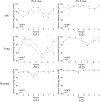An optimized framework for cone-beam computed tomography-based online evaluation for proton therapy
- PMID: 37450315
- PMCID: PMC11700505
- DOI: 10.1002/mp.16625
An optimized framework for cone-beam computed tomography-based online evaluation for proton therapy
Abstract
Background: Clinical evidence has demonstrated that proton therapy can achieve comparable tumor control probabilities compared to conventional photon therapy but with the added benefit of sparing healthy tissues. However, proton therapy is sensitive to inter-fractional anatomy changes. Online pre-fraction evaluation can effectively verify proton dose before delivery to patients, but there is a lack of guidelines for implementing this workflow.
Purpose: The purpose of this study is to develop a cone-beam CT-based (CBCT) online evaluation framework for proton therapy that enables knowledge transparency and evaluates the efficiency and accuracy of each essential component.
Methods: Twenty-three patients with various lesion sites were included to conduct a retrospective study of implementing the proposed CBCT evaluation framework for the clinic. The framework was implemented on the RayStation 11B Research platform. Two synthetic CT (sCT) methods, corrected CBCT (cCBCT), and virtual CT (vCT), were used, and the ground truth images were acquired from the same-day deformed quality assurance CT (dQACT) for the comparisons. The evaluation metrics for the framework include time efficiency, dose-difference distributions (gamma passing rates), and water equivalent thickness (WET) distributions.
Results: The mean online CBCT evaluation times were 1.6 ± 0.3 min and 1.9 ± 0.4 min using cCBCT and vCT, respectively. The dose calculation and deformable image registration dominated the evaluation efficiency, and accounted for 33% and 30% of the total evaluation time, respectively. The sCT generation took another 19% of the total time. Gamma passing rates were greater than 91% and 97% using 1%/1 mm and 2%/2 mm criteria, respectively. When the appropriate sCT was chosen, the target mean WET difference from the reference were less than 0.5 mm. The appropriate sCT method choice determined the uncertainty for the framework, with the cCBCT being superior for head-and-neck patient evaluation and vCT being better for lung patient evaluation.
Conclusions: An online CBCT evaluation framework was proposed to identify the use of the optimal sCT algorithm regarding efficiency and dosimetry accuracy. The framework is extendable to adopt advanced imaging methods and has the potential to support online adaptive radiotherapy to enhance patient benefits. It could be implemented into clinical use in the future.
Keywords: CBCT-based evaluation; online adaptation; proton therapy.
© 2023 American Association of Physicists in Medicine.
Conflict of interest statement
CONFLICT OF INTEREST STATEMENT
The second and third author are employees of Ray-Search Laboratory. There is no financial or funding support from RaySearch Laboratory.
Figures





Similar articles
-
Direct-to-Treatment Adaptive Radiation Therapy: Live Planning of Spine Metastases Using Novel Cone Beam Computed Tomography.Int J Radiat Oncol Biol Phys. 2025 Jul 15;122(4):1045-1053. doi: 10.1016/j.ijrobp.2025.02.045. Epub 2025 Mar 9. Int J Radiat Oncol Biol Phys. 2025. PMID: 40068776
-
Clinical comparison of adaptive 4DCBCT scanning protocols for lung tumor motion assessment.J Appl Clin Med Phys. 2025 Jul;26(7):e70172. doi: 10.1002/acm2.70172. J Appl Clin Med Phys. 2025. PMID: 40657701 Free PMC article.
-
Hounsfield Unit characterization and dose calculation on a C-arm linac with novel on-board cone-beam computed tomography feature and advanced reconstruction algorithms.J Appl Clin Med Phys. 2025 Aug;26(8):e70145. doi: 10.1002/acm2.70145. J Appl Clin Med Phys. 2025. PMID: 40714930 Free PMC article.
-
Home treatment for mental health problems: a systematic review.Health Technol Assess. 2001;5(15):1-139. doi: 10.3310/hta5150. Health Technol Assess. 2001. PMID: 11532236
-
Cost-effectiveness of using prognostic information to select women with breast cancer for adjuvant systemic therapy.Health Technol Assess. 2006 Sep;10(34):iii-iv, ix-xi, 1-204. doi: 10.3310/hta10340. Health Technol Assess. 2006. PMID: 16959170
Cited by
-
A retrospective study on the investigation of potential dosimetric benefits of online adaptive proton therapy for head and neck cancer.J Appl Clin Med Phys. 2024 May;25(5):e14308. doi: 10.1002/acm2.14308. Epub 2024 Feb 18. J Appl Clin Med Phys. 2024. PMID: 38368614 Free PMC article.
-
A planning approach for online adaptive proton therapy to cope with cone beam computed tomography inaccuracies.Phys Imaging Radiat Oncol. 2025 Mar 20;34:100752. doi: 10.1016/j.phro.2025.100752. eCollection 2025 Apr. Phys Imaging Radiat Oncol. 2025. PMID: 40213031 Free PMC article.
-
Exploration of an adaptive proton therapy strategy using CBCT with the concept of digital twins.Phys Med Biol. 2025 Jan 17;70(2):025010. doi: 10.1088/1361-6560/ada684. Phys Med Biol. 2025. PMID: 39761649 Free PMC article.
-
Deep learning-based Fast Volumetric Image Generation for Image-guided Proton Radiotherapy.IEEE Trans Radiat Plasma Med Sci. 2024 Nov;8(8):973-983. doi: 10.1109/trpms.2024.3439585. IEEE Trans Radiat Plasma Med Sci. 2024. PMID: 40385936
-
Comparing methods to improve cone-beam computed tomography for dose calculations in adaptive proton therapy.Phys Imaging Radiat Oncol. 2025 May 16;34:100784. doi: 10.1016/j.phro.2025.100784. eCollection 2025 Apr. Phys Imaging Radiat Oncol. 2025. PMID: 40496807 Free PMC article.
References
-
- van de Water TA, Lomax AJ, Bijl HP, et al. Potential benefits of scanned intensity-modulated proton therapy versus advanced photon therapy with regard to sparing of the salivary glands in oropharyngeal cancer. Int J Radiat Oncol Biol Phys 2011;79(4):1216–1224. - PubMed
-
- Baumann M, Krause M, Overgaard J, et al. Radiation oncology in the era of precision medicine. Nat Rev Cancer. 2016;16(4):234–249. - PubMed
-
- Thirion JP. Image matching as a diffusion process: an analogy with Maxwell’s demons. Med Image Anal 1998;2(3):243–260. - PubMed
MeSH terms
Substances
Grants and funding
LinkOut - more resources
Full Text Sources

